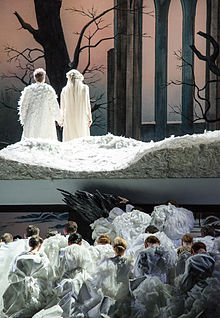Lohengrin (opera)
| Lohengrin | |
|---|---|
| Opera by Richard Wagner | |

Production of the Oslo Opera in 2015
|
|
| Librettist | Richard Wagner |
| Language | German |
| Based on | Medieval German Romance |
| Premiere | 28 August 1850 Deutsches Nationaltheater Weimar |
Lohengrin, WWV 75, is a Romantic opera in three acts composed and written by Richard Wagner, first performed in 1850. The story of the eponymous character is taken from medieval German romance, notably the Parzival of Wolfram von Eschenbach and its sequel, Lohengrin, written by a different author, itself inspired by the epic of Garin le Loherain. It is part of the Knight of the Swan tradition.
The opera has inspired other works of art. King Ludwig II of Bavaria named his fairy-tale castle "New Swan Castle", or "Neuschwanstein", after the Swan Knight. It was King Ludwig's patronage that later gave Wagner the means and opportunity to compose, build a theatre for, and stage his epic cycle The Ring of the Nibelung.
The most popular and recognizable part of the opera is the Bridal Chorus, better known as "Here Comes the Bride", often played as a processional at weddings in the West.
The literary figure of Lohengrin first appeared as a supporting character in the final chapter of the middle-age epic poem Parzival of Wolfram von Eschenbach. The Grail Knight Lohengrin, son of the Grail King Parzival, is sent to the duchess of Brabant to defend her. His protection comes under the condition that she must never ask his name. If she violates this requirement, he will be forced to leave her. Wagner took up these characters and set the "forbidden question" theme at the core of a story which makes contrasts between the godly and the mundane, and between Early Middle Age Christendom and Germanic paganism. Wagner attempted at the same time to weave elements of Greek tragedy into the plot. He wrote the following in Mitteilungen an meine Freunde about his Lohengrin plans:
...
Wikipedia
